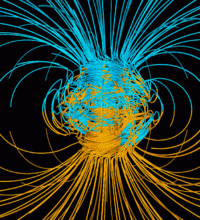
Photo from wikipedia
The first extensive study of interplanetary magnetic field (IMF) characteristics and stability at Mercury is undertaken using MErcury Surface, Space ENvironment, GEochemistry, and Ranging (MESSENGER) magnetometer data. Variations in IMF… Click to show full abstract
The first extensive study of interplanetary magnetic field (IMF) characteristics and stability at Mercury is undertaken using MErcury Surface, Space ENvironment, GEochemistry, and Ranging (MESSENGER) magnetometer data. Variations in IMF and solar wind conditions have a direct and rapid effect upon Mercury's highly dynamic magnetosphere; hence, understanding of the time scales over which these variations occur is crucial because they determine the duration of magnetospheric states. We characterize typical distributions of IMF field strength, clock angle, and cone angle throughout the duration of MESSENGER's mission. Clock and cone angle distributions collected during the first Earth year of the mission indicate that there was a significant north-south asymmetry in the location of the heliospheric current sheet during this period. The stability of IMF magnitude, clock angle, cone angle, and IMF Bz polarity is quantified for the entire mission. Changes in IMF Bz polarity and magnitude are found to be less likely for higher initial field magnitudes. Stability in IMF conditions is also found to be higher at aphelion (heliocentric distance r ∼ 0.31 AU) than at perihelion (r ∼ 0.47 AU).
Journal Title: Journal of Geophysical Research
Year Published: 2017
Link to full text (if available)
Share on Social Media: Sign Up to like & get
recommendations!